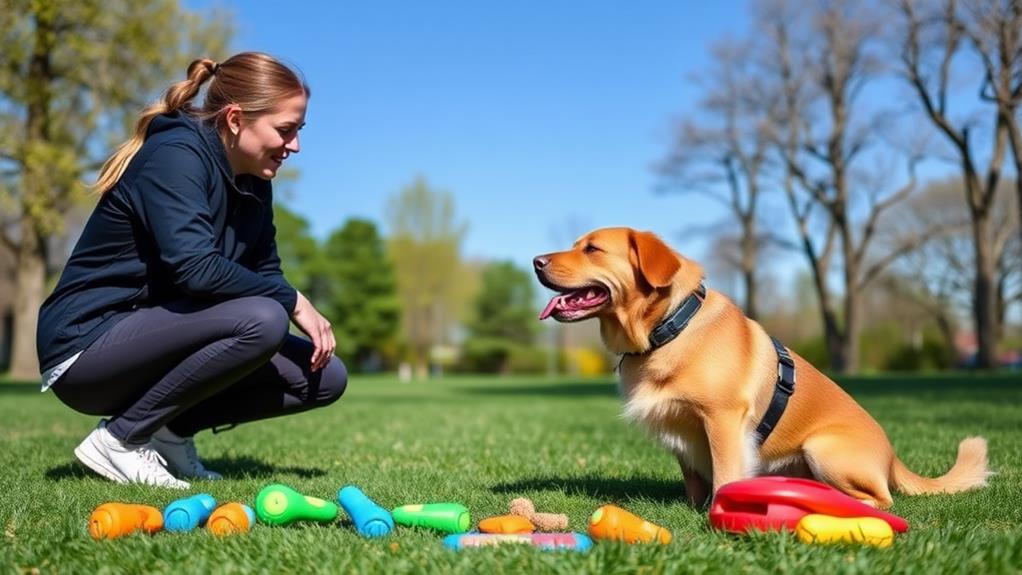To train your dog effectively, start by understanding their behavior, observing their signals and body language. Next, set clear training goals like "sit" or "stay" to keep your aims focused. Use positive reinforcement, rewarding good actions with treats or praise to encourage good behavior. Establish a routine with short, enjoyable sessions and be consistent with commands to avoid confusion. Don't forget to socialize your dog, exposing them to new people and environments. Finally, monitor their progress and make adjustments as needed to enhance learning. Follow these steps, and you'll discover even more tips for successful training.
Understand Your Dog's Behavior
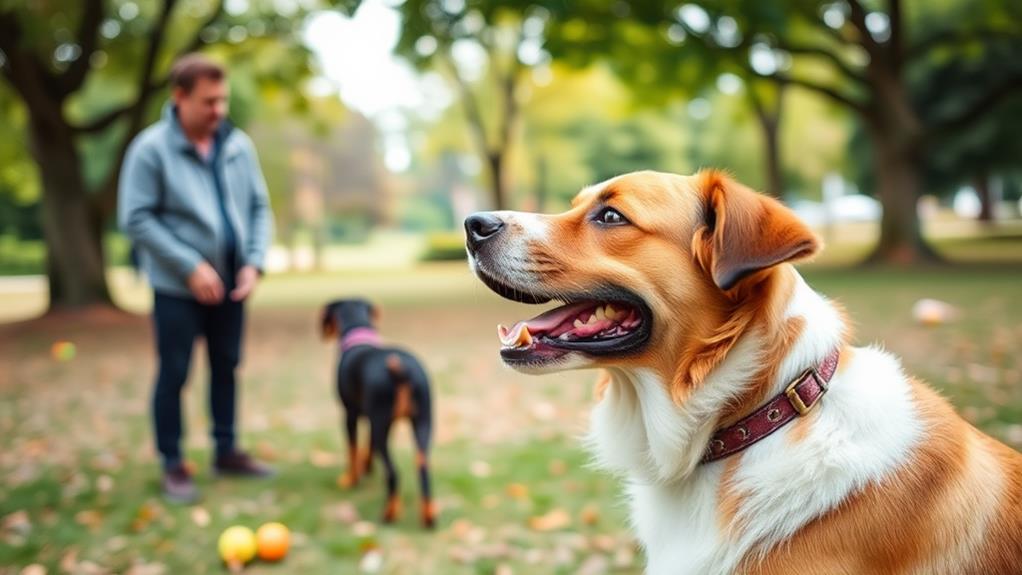
To effectively train your dog, you'll often need to understand their behavior. Dogs communicate through their actions, sounds, and body language, so paying attention is vital. When your dog barks, whines, or growls, consider what they might be expressing. For instance, barking can indicate excitement, anxiety, or a need for attention. By recognizing these cues, you can respond appropriately and tailor your training.
Observe your dog's body language, too. A wagging tail usually signifies happiness, while a stiff posture may suggest fear or aggression. Understanding these signals helps you manage your dog's reactions and builds a stronger bond between you two.
Also, consider the environment around your dog. Are there distractions, like other animals or loud noises? These factors can influence their behavior and focus during training sessions. By creating a calm and controlled atmosphere, you can enhance their ability to learn.
Set Clear Training Goals
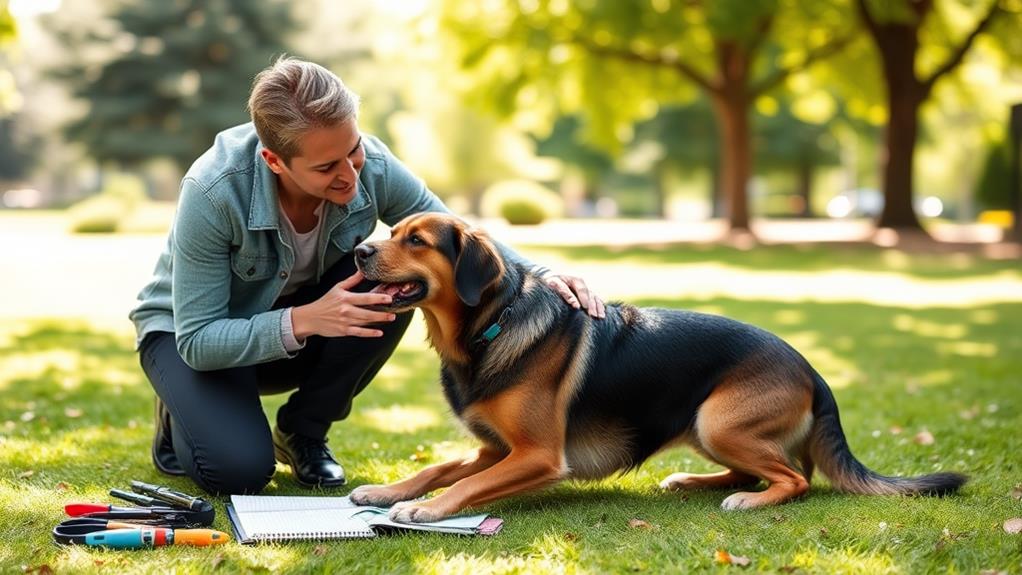
Setting clear training goals is essential for successful dog training. When you establish specific objectives, you provide direction for yourself and your dog. This clarity helps you stay focused and encourages progress. Without defined goals, training can feel overwhelming and unproductive.
Here are four key elements to ponder when setting your training goals:
- Be Specific: Instead of saying "I want my dog to be obedient," specify what behaviors you want to teach, like "sit" or "stay" in various environments.
- Make It Measurable: Set criteria to track your dog's progress. For example, "My dog will sit on command 8 out of 10 times."
- Set Realistic Timelines: Give yourself and your dog a reasonable timeframe to achieve these goals. Aiming for improvement over weeks or months makes training more manageable.
- Celebrate Small Wins: Acknowledge progress, no matter how small. Celebrating these achievements boosts your motivation and strengthens the bond with your dog.
Use Positive Reinforcement
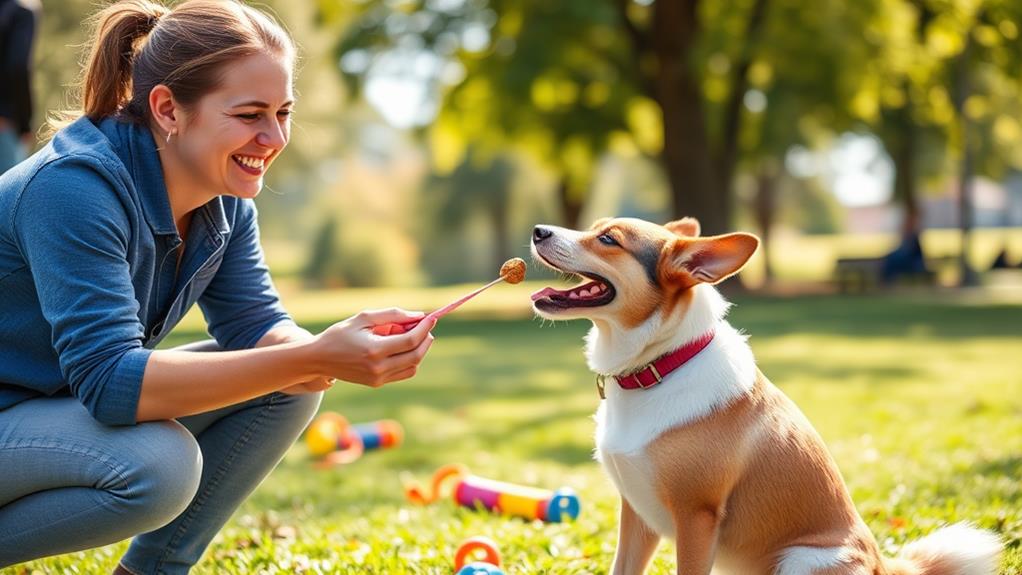
Positive reinforcement is one of the most effective techniques for training your dog. This method involves rewarding your dog for good behavior, which encourages them to repeat that behavior in the future. When your dog sits, stays, or performs any desired action, immediately reward them with treats, praise, or playtime. This way, your dog learns to associate those actions with positive outcomes.
Timing is essential. You should reward your dog right after they perform the desired behavior to reinforce the connection. For example, if your dog sits on command, give them a treat within seconds of them sitting. This helps them understand exactly what they're being rewarded for.
Be consistent with your rewards. Use the same treats or praise every time, and make sure everyone in your household is on the same page. This consistency helps your dog learn faster and reduces confusion.
Remember to keep training sessions short and fun. This keeps your dog engaged and motivated. Over time, you can gradually reduce the treats, relying more on verbal praise or affection. By using positive reinforcement, you'll build a strong bond with your dog while effectively guiding their behavior.
Establish a Training Routine
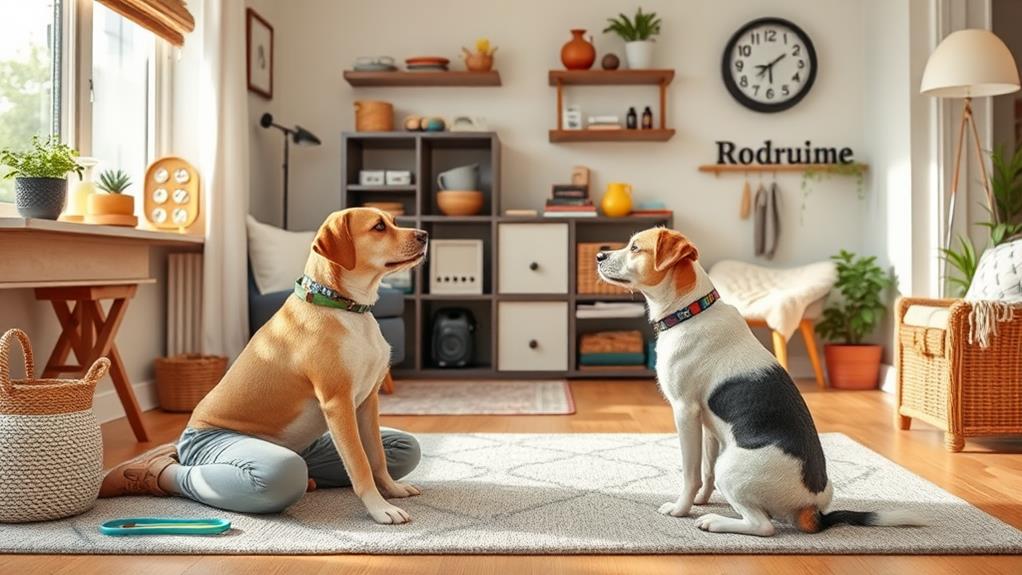
A consistent training routine is crucial for your dog's success. Establishing a routine not only helps your dog learn faster but also strengthens the bond between you two.
Dogs thrive on predictability, so set aside dedicated time each day for training sessions. Here are some key elements to include in your routine:
- Choose the Right Time: Pick a time when your dog is most alert and energetic, like after a walk or playtime.
- Keep Sessions Short: Aim for 5-10 minute sessions to maintain your dog's interest and prevent frustration.
- Be Engaging: Use enthusiastic praise and rewards during training. Your excitement will motivate your dog to respond positively.
- Create a Calm Environment: Minimize distractions to help your dog focus better. A quiet space allows for effective learning.
Be Consistent With Commands
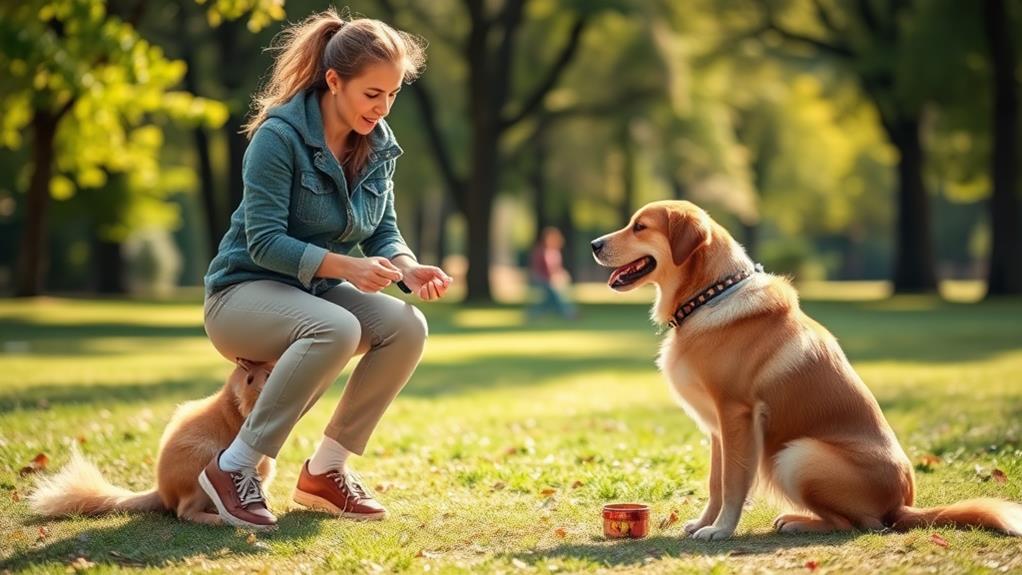
Consistency in the commands you use during training is essential for your dog's understanding. When you repeat the same words for specific behaviors, your dog learns to associate them with actions. If you switch commands or use different phrases, you'll confuse your furry friend, making training less effective.
Here's a simple table to illustrate the impact of consistency on your dog's behavior:
| Command | Emotion Evoked |
|---|---|
| Sit | Happy and relaxed |
| Stay | Safe and secure |
| Come | Joyful excitement |
| Heel | Calm and in control |
| Down | Peaceful and at ease |
When you stick to the same commands, your dog feels more confident and secure in responding. This not only strengthens your bond but also builds trust. Remember, dogs thrive on routine, and your consistency reinforces their learning.
Socialize Your Dog Properly
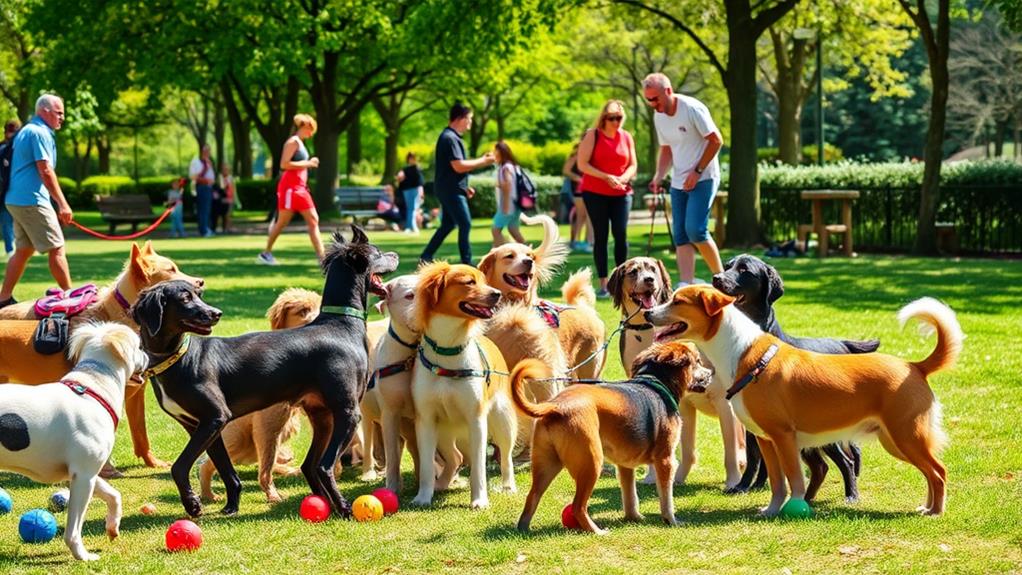
Socializing your dog with a variety of people and environments is crucial for their development. It helps them become well-adjusted, confident, and friendly companions. When you expose your dog to new experiences, they learn to adapt and respond positively to the world around them.
Some key steps to promote effective socialization:
- Introduce new people: Invite friends or family over to interact with your dog. Positive experiences with different individuals will foster trust and comfort.
- Visit different places: Take your dog to parks, pet-friendly stores, or outdoor cafes. Each new location introduces unique sights, sounds, and smells, broadening their experiences.
- Engage with other dogs: Arrange playdates or visit dog parks. Interacting with fellow canines helps your dog learn social cues and appropriate behaviors.
- Expose them to various environments: Whether it's a bustling city street or a quiet nature trail, exposing your dog to diverse settings will build their confidence and adaptability.
Monitor Progress and Adjust
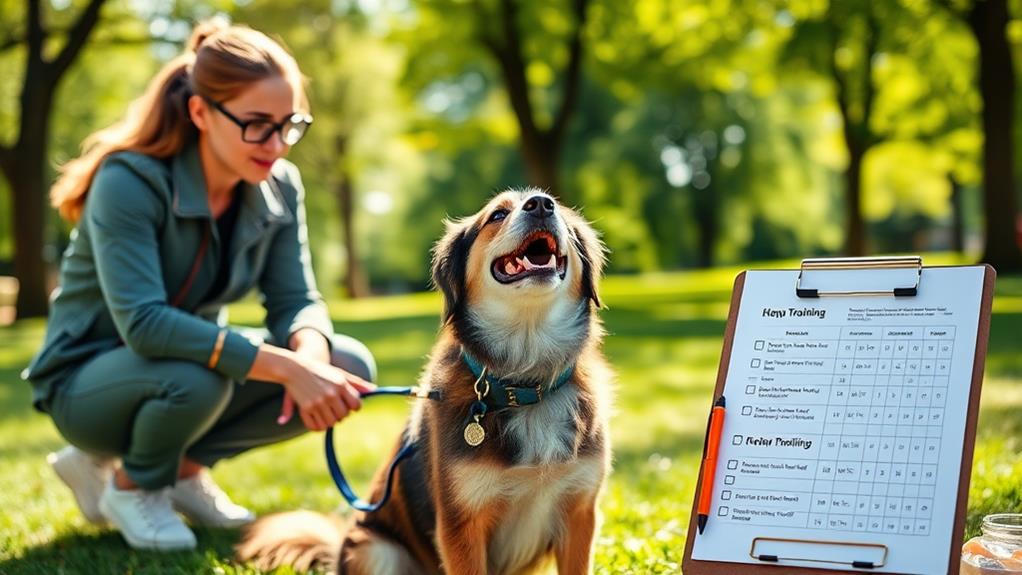
Tracking your dog's progress is essential to effective training. By monitoring how your dog responds to various commands and situations, you can identify what's working and what isn't. Keep a training journal, noting each session's successes and challenges. This will help you see patterns and make informed adjustments.
If your dog isn't responding well to a particular command, don't hesitate to change your approach. Try different rewards or techniques to see what resonates best with your pup. For example, if treats aren't motivating, consider using toys or praise instead.
Regularly assess your training goals, too. If your dog masters a command, it's time to raise the bar. Introduce distractions or practice in different environments to enhance their skills. Remember, training isn't a one-size-fits-all process; flexibility is key.
Lastly, celebrate your dog's achievements, no matter how small. Positive reinforcement boosts their confidence and strengthens your bond. By staying engaged and responsive to your dog's needs, you'll create a more effective training experience that fosters growth for both of you. Adapt, adjust, and watch your dog thrive!
Frequently Asked Questions
What Age Is Best to Start Training My Dog?
You can start training your dog as early as eight weeks old. Puppies are enthusiastic to learn and absorb information quickly. Early training helps shape their behavior and strengthens your bond with them for life.
How Long Should Each Training Session Last?
Each training session should last about 5 to 15 minutes, depending on your dog's age and attention span. Short, focused sessions keep your pup engaged and make learning more enjoyable for both of you.
Can I Train More Than One Dog at a Time?
Yes, you can train more than one dog at a time, but it's vital to keep their attention focused. Guarantee each dog gets individual attention to reinforce their training and avoid confusion between commands.
What Should I Do if My Dog Doesn't Respond to Treats?
If your dog's ignoring treats, don't worry; it happens! Try using higher-value rewards like toys or praise. Also, guarantee you're in a distraction-free environment to help your dog focus better on you.
Is It Ever Too Late to Train an Adult Dog?
It's never too late to train an adult dog! With patience and consistency, you can teach new behaviors regardless of age. Focus on positive reinforcement, and you'll see progress in your dog's learning journey.
Conclusion
In the world of dog training, the theory that consistency and positive reinforcement lead to success holds true. By understanding your dog's behavior and setting clear goals, you're not just teaching commands; you're building a stronger bond. Remember, every dog learns at their own pace, so stay patient and adapt your methods as needed. With these seven simple steps, you'll see real progress, proving that effective training is both achievable and rewarding. Enjoy the journey with your furry friend!

